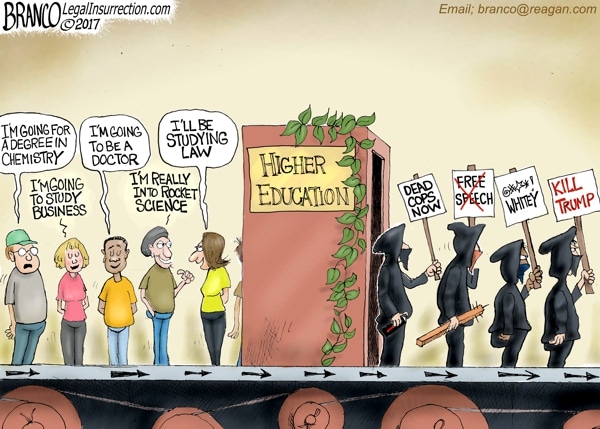September 5, 2023
Permission to republish original opeds and cartoons granted.
Democrats’ edge among college graduates remains tilted because 76 million women have attended college compared to 67.9 million men

By Robert Romano
In recent U.S. elections, Democrats have tended to perform better among college graduates with bachelor’s degrees or higher while Republicans have tended to do better among those with either no college or among associate’s degree graduates.
For example, in 2022, in the election for the U.S. House, those with bachelor’s degrees preferred the Democratic candidate 52 percent to 46 percent and those with master’s degrees or higher preferred the Democratic candidate, 57 percent to 41 percent, according to the CNN exit poll.
Whereas, those with no college preferred the Republican candidate 62 percent to 36 percent, those with some college 51 percent to 47 percent and those with an associate’s degree 54 percent to 44 percent.
Similar patterns played out in 2020, 2018 and 2016 with some variation: Democrats won some college voters in 2020 and 2018, and Republicans won them in 2016. Otherwise, Democrats have still had an edge among bachelor’s degree and above voters, and Republicans consistently did much better with no-college and associate’s degree voters.
But it’s super easy to see why that is when one examines the population of college attendees according to the latest data from the Bureau of Labor Statistics: It’s the gender gap.
In short, 76 million women attended college, including 16.75 million with some college, 12.6 million with associate’s degrees, 28.2 million with bachelor’s degrees and 18.4 million with master’s degrees or above.
Comparatively, only 67.9 million men have attended college, including 16.1 million with some college, 10.87 million with associate’s degrees, 25.25 million with bachelor’s degrees and 15.75 million with master’s degrees or above.
Whereas, there are 42.8 million men who have not gone to college compared with 40.7 million women who have not gone to college.
As a result, 65 percent of working aged women have attended college at some level, compared with 61.3 percent of men, a trend that has been going on since the 1980s as female enrollment in higher education has outpaced men, who are more likely to work blue collar jobs including manual labor.
In other words, women have 52.7 percent of all the bachelor’s degrees and 53.8 percent of all the master’s degrees and above, as 52.8 percent of those who attended college were women, compared to 47.2 percent of men.
But the trend has become more exacerbated in recent years as recent enrollees to four-year colleges are 1.3 to 1 female to male as of 2019, according to Oksana Leukhina and Amy Smaldone of the Federal Reserve Bank of St. Louis. That’s 56.5 percent to 43.5 percent, female to male in higher education, disproportionate compared to national data.
Looking at the CNN exit polls again, in 2020, females voted for Joe Biden over Donald Trump 57 percent to 42 percent, whereas males preferred Trump 53 percent to 45 percent.
In 2022, the gender gap evened out some, with 53 percent of women voting Democratic to 45 percent, whereas men preferred the Republican candidate 56 percent to 42 percent.
But that still shows the persistent gender gap: men are more likely to vote Republican, and women are more likely to vote Democratic.
As a result, in 2020, 55 percent of college graduates preferred Biden, with 43 percent for Trump, and those without college degrees wanted Trump over Biden, 50 percent to 48 percent. In 2022, amid heavier Republican turnout, it was 54 percent of college graduates voting Democratic and 44 percent Republican, and 55 percent of those with no degree voting Republican to 43 percent Democratic.
In terms of voting patterns, Democrats appear to have a political incentive to promote college education. For example, in 2022, white women with college degrees voted Democratic 56 percent to 42 percent. Whereas white women with no degree voted Republican 61 percent to 37 percent.
And Republicans appear have a political incentive to shun college education, with white men with a college degree voting Republican 52 percent to 45 percent, and white men with no degree voting Republican 72 percent to 26 percent.
The end result will be that as men go to college less, they’ll become more Republican, and as women attend college more, they’ll become more Democratic.
One of the side effects of this disparity is the not only the advantage Democrats possess among college graduates in voting, but also representation in the jobs that require college educations, including teaching, media and government bureaucracy, institutional bias Republicans often complain about. No wonder.
Robert Romano is the Vice President of Public Policy at Americans for Limited Government Foundation.
Video: STOP Biden’s Takeover of Your Prescription Drugs!

To view online: https://www.youtube.com/watch?v=pWiWkICC6Po


Jeff Stein: U.S. deficit explodes even as economy grows
By Jeff Stein
Morning light inside the Capitol Rotunda. Congress will return soon to try to come to an agreement on federal spending for the next fiscal year, but rising deficits could complicate lawmakers' work. (Matt McClain/The Washington Post)
The federal deficit is projected to roughly double this year, as bigger interest payments and lower tax receipts widen the nation’s spending imbalance despite robust overall economic growth.
After the government’s record spending in 2020 and 2021 to combat the impact of covid-19, the deficit dropped by the greatest amount ever in 2022, falling from close to $3 trillion to roughly $1 trillion. But rather than continue to fall to its pre-pandemic levels, the deficit then shot upward. Budget experts now project that it will probably rise to about $2 trillion for the fiscal year that ends Sept. 30, according to the Committee for a Responsible Federal Budget, a nonpartisan group that advocates for lower deficits. (These numbers ignore President Biden’s $400 billion student debt cancellation policy, which was struck down by the Supreme Court this year and never took effect.)
The unexpected deficit surge, which comes amid signs of strong growth in the economy overall, is likely to shape a fierce debate on Capitol Hill about the nation’s fiscal policies as lawmakers face a potential government shutdown this fall and choices over trillions of dollars in expiring tax cuts. The Senate will return this week from August recess, and the House will be back the following week. Biden and House Speaker Kevin McCarthy (R-Calif.) approved a deal in June to raise the nation’s borrowing limit, but it did little to alter the long-term debt trajectory.
The higher deficit may undermine Biden’s attempts to take credit for reining in the budget ahead of the 2024 presidential election. And it could pose a challenge to Republican lawmakers, who — despite their calls for fiscal responsibility — are pushing to extend more than $3 trillion in tax cuts they approved in 2017.
“The deficit will basically double from 2022 to 2023,” said Marc Goldwein, senior vice president of the Committee for a Responsible Federal Budget. “This should prompt a serious evaluation of federal policy going forward, though I worry it won’t.”
The surge in red ink has confounded many economists’ expectations. Typically, deficits contract when the economy grows, because businesses and consumers owe more in taxes and the government does not need to spend as much to protect those who have lost their job. Then deficits normally expand again in downturns, as those factors go into reverse. And yet the current surge in the deficit is coinciding with a period of unusually strong economic growth, amid historic lows in unemployment and robust corporate profits.
Jason Furman, who served as a top economist in the Obama administration and is now an economics professor at Harvard, said the current jump in the deficit is only surpassed by “major crises,” such as World War II, the 2008 financial meltdown or the coronavirus pandemic. Only during these national catastrophes did the United States see deficit numbers this large as a share of the economy or this substantial an increase in the deficit, Furman said. The U.S. economy is expected to grow at a steady 2.1 percent this year.
“To see this in an economy with low unemployment is truly stunning. There’s never been anything like it,” Furman said. “A good and strong economy, with no new emergency spending — and yet a deficit like this. The fact that it is so big in one year makes you think it must be some weird freakish thing going on.”
From August 2022 to this July, the federal government spent roughly $6.7 trillion while bringing in roughly $4.5 trillion. That represents a total increase in spending of 16 percent relative to last year and a 7 percent decrease in revenue, according to the Committee for a Responsible Federal Budget.
The deficit fell dramatically the year before in large part because of the expiration of trillions in emergency covid aid approved during the Trump and Biden administrations. But even as covid spending continued to fall this year, other factors pushed overall spending up.
Get the full story here: https://www.washingtonpost.com/business/2023/09/03/us-debt-deficit-rises-interest-rate/

